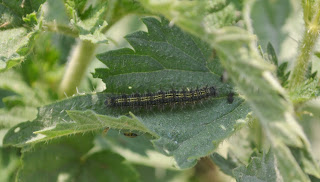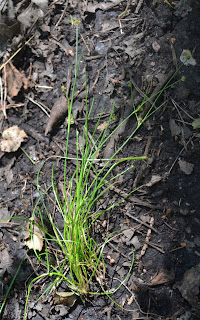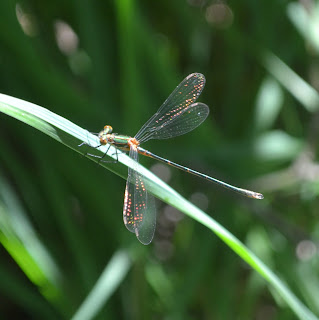22 July 2013
All day OS
map 174 Newbury & Wantage
St. Mary's Churchyard, Upton
On the external
wall of the churchyard were pellitory-of-the-wall Parietaria judaica, black horehound Ballota nigra, wall barley Hordeum
murinum, red valerian Centranthus
ruber, prickly lettuce Lactuca
serriola and fox and cubs in seed Pilosella
aurantiaca. The church walls had
little except hartstongue fern Phyllitis
scolopendrium, and the grassland nothing more exceptional than hoary
plantain Plantago media, chalk
knapweed Centaurea debeauxii and
burnet saxifrage Pimpinella saxifraga,
reflecting the chalky soil.
Hoary plantain, Upton
There were a
couple of interesting introduced plants, however, near the church porch. One, perennial candytuft Iberis sempervirens, is mentioned as being here in the Berks flora
and therefore appears naturalised.
Perennial candytuft
The other, hybrid
clary Salvia x sylvestris, seems equally
established. It has a spike of
relatively small flowers but colour is added by the large purple bracts beneath
each flower.
Hybrid clary
We walked north on
the west side of the church, turned left and then right, this lane leading to a
path approaching the embankment of the railway which was abandoned in
1962. The way along the top is now a
footpath and cycleway and this was being enjoyed by many cyclists, walkers and
young families. The embankment either
side of the bridge where the path meets it, and on top, has a well-established
colony of the rare hybrid knapweed Centaurea
x gerstlaueri, a cross between the almost extinct alien C. jacea (brown knapweed) and either
common knapweed C. nigra or chalk
knapweed. The heads underneath the
flowers have the pale brown appearance of jacea,
but the filaments on the upper part of each scale (phyllary) are intermediate
between that and chalk knapweed (obviously the other parent in this case, as it
also grows here). The flower-heads are
bordered by the enlarged pseudo-radiate flowers as is often the case with debeauxii, as it is with greater
knapweed C. scabiosa, which was
abundant along the embankment but has darker purple rays. Some of the leaves of the hybrid were
somewhat lobed, but nowhere near as much as the scabiosa.
Hybrid knapweed Centaurea x gerstlaueri
Upper: phyllaries of
hybrid knapweed
Lower: phyllaries of chalk
knapweed
Flower-heads of (left)
hybrid and (right) chalk knapweeds
The greater
knapweed (and spear thistles Cirsium
vulgare) attracted many insects, especially hoverflies, bees and
butterflies (including marbled white).
Bumble-bee mimic hoverfly Eristalis intricarius on greater
knapweed
Large white on greater
knapweed
Another thistle
here was the uncommon and impressive woolly thistle, just coming into flower at
this date.
Woolly thistle
The rest of the tall-grass chalk flora along the embankment consisted of the expected plants like wild basil Clinopodium vulgare, although there were large amounts of kidney vetch Anthyllis vulneraria and some dwarf thistle Cirsium acaule, small scabious Scabiosa columbaria, dark mullein Verbascum nigrum, meadow cranesbill Geranium pratense and chicory Cichorium intybus.
We walked north along the embankment
to the second track off to the right, leading to East
Hagbourne . This debouches
into a track beside a chalk stream, where there was abundant fool's watercress Apium nodiflorum, meadowsweet Filipendula ulmaria, water figwort Scrophularia aquaticum and marsh
horsetail Equisetum palustre.
Fool's watercress, East Hagbourne
Marsh horsetail
Passing the church
on our left the stream also featured the leaves of marsh marigold Caltha palustris. The churchyard had little of interest apart
from common garden escapes, but did feature a good cluster of Pontic blue
sow-thistle Cicerbita bourgaei, told
from other blue sow-thistles by the lack of sticky hairs and the pale purplish
flowers.
Pontic blue sow-thistle, East Hagbourne churchyard
We continued east
along the main street, but there were few wild-growing plants, the village
obviously priding itself on its neat appearance, perhaps with a Best Kept
Village
We took a footpath
to the right through the little village
of Tadley
Scented mayweed
Many-seeded goosefoot
Long-headed poppy
Rough mallow
We also passed
hops Humulus lupulus in a hedgerow,
clover broomrape Orobanche minor, and
a white specimen of chalk knapweed.
Clover broomrape
White form of chalk
knapweed
The path crossed
Mill Brook, which had chalk-stream water-crowfoot Ranunculus penicillatus.
Chalk-stream
water-crowfoot
Tansy
We had hoped to
eat at the pub in Aston Tirrold, the Sweet Olive, but this was closed and there
was no shop here, so we had to continue with dwindling water supplies on what
was now the hottest day of the year so far, with temperatures soaring to
34ºC. There was little choice, but to
continue, however, as the rest of our route was directly towards our
starting-point. We walked west through
Aston Upthorpe and along the track along Blewburton Hill. This passed between tall crowded plants of
chicory and greater knapweed.
Chicory, Blewburton Hill
Squinancywort on
Blewburton Hill
Small tortoiseshell
caterpillar on nettle
Opposite the farm
at the bottom of the hill a row of planted bird cherry Prunus padus was fecund with fruit and harboured mating forest bugs
Pentatoma rufipes.
Bird cherry
We continued due
west along the main street in Blewbury, with a clump of the garden escape red
bistort Persicaria amplexicaulis in
the verge beside a stream with brooklime Veronica
beccabunga and blue water speedwell V.
anagallis-aquatica.
Red bistort
At the far end is
a community centre with a small post office, apparently the only shop in all
the villages we had visited. While it
had little for sale it satisfied very well the desperate need by now for cold
ice-lollies! Nearby grew a couple of
plants of another much less familiar garden escape, tall eryngo Eryngium giganteum.
Tall eryngo
But we had yet to
finish with interesting escapes. We left
Blewbury along the footpath to Upton Somerset "
skullcap Scutellaria altissima, named
from the fact that there has been an established population in Somerset
Melica
altissima 'Atropurpurea'
Hoverfly Chrysotoxum bicinctum
The open fields
beyond had much crow garlic Allium
vineale at the edge of the crops, in which also grew the invasive great
brome Anisantha diandra. By a stream close to Upton
Elecampane
From here it was
just a short way back to Upton
Old buildings at Upton






































































